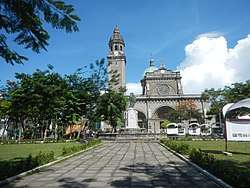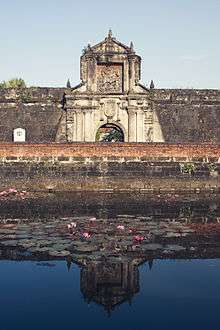Plaza de Roma
Plaza de Roma, also known as Plaza Roma, is one of three major public squares in Intramuros, Manila. It is bounded by Andres Soriano Avenue (formerly Calle Aduana) to the north, Cabildo Street to the east, Santo Tomas Street to the south, and General Antonio Luna Street (formerly Calle Real del Palacio) to the west. The plaza is considered to be the center of Intramuros.
| Plaza de Roma | |
|---|---|
| Public square | |
 Plaza de Roma is dominated by the Manila Cathedral, the seat of the Roman Catholic Archdiocese of Manila. | |
| Location | Andrés Soriano Avenue, Intramuros Manila, Philippines |
| Coordinates: 14°35′32″N 120°58′23″E | |
Plaza de Roma is also the location of the Book Stop Intramuros, a local unit of The Book Stop Project.[1]
History
During Spanish colonial times, the plaza was the Plaza Mayor of Manila, and was thus considered the center of the city, with bullfights and other public events being held in the plaza until Governor-General Rafael Maria de Aguilar converted it into a garden in 1797.[2] It was also often referred to as the Plaza de Armas (not to be confused with the Plaza de Armas inside Fort Santiago) during this time. In 1901, with the start of American rule, the plaza was renamed Plaza McKinley, after U.S. President William McKinley, who authorized the colonization of the Philippines by the United States. The plaza was given its current name in 1961, following the elevation of Rufino Santos to the College of Cardinals of the Roman Catholic Church as the first Filipino cardinal.[3] In recognition of this, the city of Rome reciprocated by subsequently renaming one of its squares Piazzale Manila.[2]
Its current configuration as a garden does not anymore allow Plaza de Roma to function as a public square like Plaza Miranda and Plaza Moriones. However, the Intramuros Administration plans to revert the square to its appearance in the Spanish Era.[4]
Surroundings
Plaza de Roma is surrounded by three important landmarks of Intramuros: the Manila Cathedral to the south, the Palacio del Gobernador to the west, and the Casas Consistoriales, also known as the Ayuntamiento de Manila, to the east. The Real Audiencia of Manila was also located in proximity to the plaza during Spanish rule.[5]
| Eastern side | ||
| Northern side | Southern side | |
| Building | Ayuntamiento de Manila [Casas Consistoriales] (Bureau of the Treasury) |
Buildings |
| Shipping Center Building |  King Charles IV Monument |
 Manila Cathedral |
| Fire Station/Philippine National Bank (pictured) | Palacio del Gobernador (Intramuros Administration) |
Parking Lot |
| Western side | ||
King Charles IV Monument
At the center of Plaza de Roma is a monument to Charles IV of Spain which was erected in 1824[3] in his honor for having sent the first batch of smallpox vaccine to the Philippines.[2] A fountain surrounding the monument was subsequently erected in 1886.[3] However, in the 1960s, the monument was replaced with a monument dedicated to the Gomburza.[6] In 1978, President Ferdinand Marcos ordered the restoration of the Plaza de Roma along with other sites in Intramuros.[7] The work was completed by the then-newly established Intramuros Administration in 1980[2] and the original Charles IV was re-installed in the plaza in 1981. The Gomburza monument was subsequently relocated to the site fronting the National Art Gallery Building of the National Museum.[3]
Book Stop Intramuros

The Plaza Roma is also the location of the Book Stop Intramuros, a local unit of The Book Stop Project.[1]
| Wikimedia Commons has media related to Plaza de Roma. |
References
- Intramuros Administration website. Award-Winning Book Stop Returns to Intramuros June 19, 2017.
- "PLAZA ROMA". Intramuros Administration. Archived from the original on July 25, 2013. Retrieved January 7, 2013.
- Valencia, Lynda B. (October 15, 2009). "Walking tour of Intramuros". Balita.ph. Retrieved January 7, 2013.
- Sardillo III, Marco Antonio Luisito (March 1, 2014). (Speech). My Filipinas 2.0: #FutureOfHeritage. Manila. Missing or empty
|title=(help) - Torres, Cristina E. (2010). The Americanization of Manila, 1898-1921. Quezon City: University of the Philippines Press. p. 20. ISBN 978-971-542-613-8.
- Gamboa, Rey (October 26, 2012). "27 Wonders of Intramuros". The Philippine Star. PhilStar Daily, Inc. Retrieved January 7, 2013.
- Republic of the Philippines. (Enacted: August 28, 1978). Letter of Instructions No. 733 - Directing the Restoration of Certain Areas in Intramuros. Retrieved January 7, 2013 from the Chan Robles Virtual Law Library.
